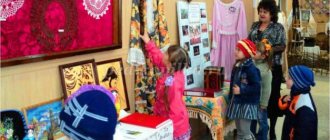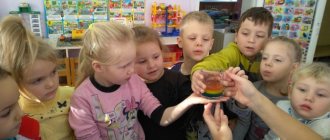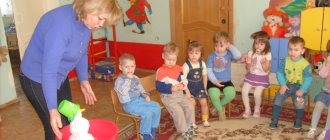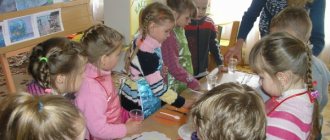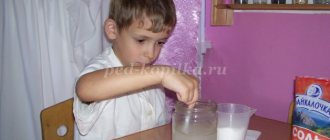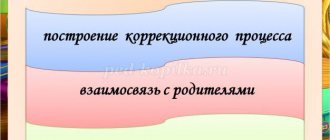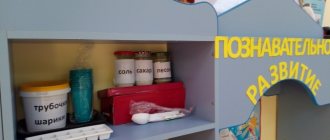Description of work experience “Experimental activities in preschool educational institutions”
Olga Kostrikova
Description of work experience “Experimental activities in preschool educational institutions”
My name is Kostrikova Olga Vitalievna! research with children . I took advanced training courses in this area. Participated in the regional pedagogical conference of preschool educational institutions employees , where she presented her work experience in the form of a presentation . Received a diploma for the best presentation of experience at the Kansk pedagogical conference of the eastern educational district of the Krasnoyarsk Territory “Modern practices of preschool education at the stage of implementation of the federal state educational standard”, Presented at the regional methodological association master class on speech development using elements of experimental activities . Many times she gave open classes for teachers in the region and city.
Currently, the latest developments , technologies, and methods are being formed and successfully applied in the preschool education system, which make it possible to raise the level of preschool education to a higher and higher quality level. One of such effective methods of understanding the patterns and phenomena of the surrounding world is experimental research activities . Children love to experiment . This is explained by the fact that they are characterized by visual-effective and visual-figurative thinking. Therefore, experimental research activity , like no other method, satisfies age characteristics. In preschool age, experimentation is the leading one , and in the first three years it is practically the only way to understand the world.
experimentation method contributes to the formation of integrative qualities of a preschooler. Ensures the integration of educational areas: “Cognitive development”
,
“Social and communicative development”
,
“Speech development”
,
“Artistic and aesthetic development”
,
“Physical development”
.
Develops the child’s interest in the world around him, activity, initiative and independence in his knowledge in the course of practical activities .
Developing a child’s research abilities is one of the most important tasks of modern education. Knowledge obtained as a result of one’s own experiment and research search is much stronger and more reliable for a child than information about the world that is obtained through reproductive means.
The main advantage of experimental research activities is that it is close to preschoolers (preschoolers are natural researchers, and gives children real ideas about the various aspects of the object being studied, about its relationships with other environmental objects.
During the experiment in addition to the development of cognitive activity , there is a development of mental processes - enrichment of memory, speech, activation of thinking, mental skills, since the need constantly arises to perform operations of analysis and synthesis, comparison and classification, the need to give an account of what was seen, to formulate discovered patterns and conclusions ; Not only does the child become familiar with new facts, but also the accumulation of a fund of mental techniques and operations.
Requirements for the modernization of education - the search for new effective forms of teaching preschoolers. In paragraph 4.6. The Federal State Educational Standards target guidelines say that it is necessary to develop in children initiative and independence in cognitive and research activities . In practice, this is carried out through the ability of children to independently perceive simple and complex experiments and draw conclusions. In the children's research laboratory, children can independently reproduce simple and more complex experiments .
I believe that in search and research activities, a preschooler gets the opportunity to directly satisfy his inherent curiosity and organize his ideas about the world. Therefore, I strive to teach not everything, but the main thing, not the sum of facts, but their holistic understanding, not so much to give the maximum information, but to teach how to navigate its flow. I want children to be attracted to experiments not only by the spectacle (changes in color, shape of liquid), but also by an understanding of how to apply this in life.
base my work on children's experimentation on the following ideas :
- a general focus on obtaining new information about a particular object, phenomenon, substance (what new we learned today by conducting experiments with air )
;
- obtaining new knowledge and information, something new, unexpected (Did you like learning the properties of air? Do you want to explore these properties further);
- accumulation of generalized research methods and methods (now you know that air is lighter than water and how this can be checked)
.
When analyzing the activity , I emphasized what has already been achieved and what needs to be strived for, namely, the children learned to analyze, draw conclusions, and can themselves explain some patterns in nature. They conduct experiments and create the conditions for conducting experiments and observations . They are responsible for doing homework. a lot of experimental activities with the children of my group, but there is still something to strive for, that is, I want the children to be able to independently:
- identify and pose a problem that needs to be resolved;
— offer possible solutions;
— test these possible solutions based on data;
— draw conclusions in accordance with the results of the inspection;
- make generalizations.
As part of the implementation of the main educational program of the preschool educational institution, in the educational field of “cognitive development”
,
the work is aimed at achieving the program goal, developing cognitive and research activities . Obtaining positive results in children’s mastery of cognitive-research activities is due to taking into account the age and individual characteristics of preschoolers and the gradual complication of program material (if in the younger group we introduce children to general methods of studying various objects and include children in practical cognitive activities jointly with adults, then in the senior preschool age, we consolidate the ability to use generalized methods of examining objects and develop the ability to determine an algorithm of activity ).
In my research work , I give preference to experiments , experiments , research activities, and independent search activities of children . I see that this type of activity delights children. Experience is fun and exciting, but at the same time, in each experience the cause of the observed phenomenon is revealed, children are led to judgment, conclusion, their knowledge about the properties and qualities of objects, about their changes is clarified. I carry them out both in educational activities and in free independent and joint activities .
Children with great pleasure conduct experiments with objects of inanimate nature: sand, clay, magnets, fabrics, snow, water, air. For example, in order to find out if there is air around us, I suggest children catch it with the help of bags, and then determine what color it is? Having collected air into bags, the children argue that it can be caught, which means it is around us and that it has no color. This is how I introduce children to the properties of air.
From experiment , when water and syrup interact, we learned about its ability to change color, the “Magic Mitten” experiment
helped to find out the ability of a magnet to attract metal objects through a mitten.
Such experiments somehow remind the kids of magic tricks, they are unusual, and most importantly, the kids do everything themselves. Our relationships with children are built on the basis of partnership. Children learn to set goals, solve problems, put forward hypotheses and test them empirically , and draw conclusions. They experience great joy, surprise and even delight from their small and big “discoveries”
which give them a feeling of satisfaction from
the work .
talk endlessly about the experiments and discoveries of young students. I have been convinced in practice that experimental activity is , along with play, the leading activity of a preschool child . The main thing is that the child’s interest in research and discoveries does not fade over time.
Perhaps in the near future, from "Know-It-Yourself"
and
“Whychek”
, graduates of my group will grow up and become outstanding scientists. At school, many children are already excellent students and athletes who defend the honor of the school and the region.
With the introduction of the Federal State Educational Standard, I am paying great attention to working with parents. Cooperation presupposes not only mutual actions, but also mutual understanding, mutual respect and trust. Active joint work helps strengthen relationships between all participants in the educational process. I consider the main tasks in interaction with parents to be:
— firstly, to establish partnerships with the family of each pupil and join efforts for the development and upbringing of children;
- secondly, create an atmosphere of community of interests;
- thirdly, to activate and enrich the educational skills of parents.
Parents take an active part in the “ Experiments at Home ”
,
"Why is that?"
help in equipping and replenishing our group’s laboratory with the necessary materials.
In individual conversations, consultations at parent meetings, and through various types of visual propaganda, I convince parents of the need for daily attention to children's experimentation . Conducted a parent meeting on the topic “Children’s
experimentation in kindergarten and at home” , a survey of parents in order to identify their attitude towards the search and research activity of children
The group has an information corner for parents on research activities . In it, parents can get advice on the topic: “Organizing children’s experimentation at home ,” booklets and recommendations: “Conducting experiments at home ”
, read the memo
“
Experimenting with water ” .
My group has created a laboratory for experimental activities in which we conduct research.
Indoor “Merry Garden”
, where together with children we grow and watch how plants grow and develop.
“Seabed” piggy banks have been collected
,
"What's Under Our Feet"
;
• Instruments – assistants for experimentation : scales, magnets, magnifying glasses, hourglasses;
•Natural materials: sand, clay, earth, seeds, pebbles of different colors and shapes, minerals, clay, earth of different compositions, coal, salt, shells, cones, nut shells, pieces of tree bark, fruit and vegetable seeds.
•Medical materials: pipettes, flasks, syringes, measuring spoons, cotton wool, bandages, test tubes, spatulas, wooden sticks, beakers, funnels, rubber bulbs of various sizes.
• Waste material: plastic, pieces of fabric, leather, fur, foam rubber, test tubes, wire,
•Transparent and opaque vessels of different configurations and different volumes:
plastic bottles, glasses, buckets, funnels.
Additional equipment and materials.
- children's robes, aprons, mantles, robes;
— schemes for conducting experiments .
The laboratory is constantly updated with new materials for experimentation , which are in a place accessible to children.
Children grow up very quickly, they can easily adapt in a social environment, they can find the right solutions on their own if we help their abilities and talents develop today. Let's awaken interest in ourselves and the world around us.
And as V. A. Sukhomlinsky said, “Always leave something unsaid so that the child wants to return to what he learned again and again.”
Practical part
Element of one of the types of experimental activities
Now I want to introduce you to an element of one of the types of experimental activities , the experience of fabric dyeing . I present to your attention a video letter
Experiment “Fabric and paints”
— Take the hoop with the fabric, three markers together in one hand and place dots on the fabric, hold until counting 3 (counting 1, 2, 3.)
.
Like this. (Teacher shows)
.
- I will show you the next action first, and then you.
-I take a syringe, tilt the fabric, and drop a few drops onto each point.
“And now you are doing the same, listening to me.” Take a syringe, tilt the cloth, and drop a few drops onto each point.
- What did you do? (The dots spread and colored the fabric)
— What happened to the dots?
- Why do you think this happened?
— The liquid dissolved the paint of the markers, just as water dissolves watercolors.
What did your dots look like?
Conclusion
The coloring of the fabric occurs from the interaction of the liquid with the marker. Fabrics are dyed with special dyes, and today we learned about an unusual way of applying a design to fabric.
- Look what a wonderful drawing each of you turned out.
And here’s what our guys came up with (showing sample drawings)
-If you look closely, what does it look like what you got? (children's answers)
You can use markers to complete your drawing.
Article: Children's experimentation as a method of cognitive development of preschool children
Children's experimentation
as a method of cognitive development of preschool children
Currently, the country is actively undergoing a process of qualitative renewal of education, its cultural, developmental, and personal potential is strengthening. Various forms of research activity are actively being introduced into the educational process.
Preschool education is designed to ensure the self-development and self-realization of the child, to promote the development of research activity and initiative of the preschooler (N.N. Poddyakov, A.N. Poddyakov, O.V. Dybina, O.L. Knyazeva). The scientific search for effective means of developing the research activity of preschool children is a pressing problem that requires theoretical and practical solutions.
Among the possible means of developing the research activity of preschoolers, children's experimentation deserves special attention.
Developing as an activity aimed at cognition and transformation of objects of the surrounding reality, children's experimentation helps to broaden their horizons, enrich the experience of independent activity, and self-development of the child.
A child is born as a researcher. An unquenchable thirst for new experiences, curiosity, a constant desire to observe and experiment, to independently seek new information about the world, are traditionally regarded as the most important features of children's behavior. Satisfying his curiosity in the process of active cognitive and research activity, which naturally manifests itself in the form of children's experimentation, the child, on the one hand, expands his ideas about the world, on the other hand, begins to master the fundamental cultural forms of ordering experience: cause-and-effect, spatial and temporal relationships, allowing you to connect individual ideas into a holistic picture of the world.
A Chinese proverb says: “Tell me and I will forget, show me and I will remember, let me try and I will understand.” This is how a child learns everything firmly and for a long time when he hears, sees and does it himself. When a child is actively involved in the process of cognition, all senses are active. Scientists have proven that the more sense organs simultaneously participate in the process of cognition, the better a person feels, remembers, comprehends, understands, assimilates, and consolidates the material being studied.
Consequently, the more actively a child touches, smells, experiments, explores, feels, observes, listens, reasons, analyzes, compares, that is, actively participates in the educational process, the faster his cognitive abilities develop and cognitive activity increases.
To date, the methodology for organizing children's experimentation has not been fully developed. This is due to many reasons: insufficient theoretical elaboration of the issue, lack of methodological literature and - most importantly - the lack of focus of teachers on this type of activity. The consequence is the slow introduction of children's experimentation into the practice of preschool institutions. Preschoolers are natural explorers. And this is confirmed by their curiosity, constant desire to experiment, desire to independently find a solution to a problem situation. The teacher’s task is not to suppress this activity, but, on the contrary, to actively help.
Definition of experimentation
Currently, we are witnessing how another effective method of understanding the patterns and phenomena of the surrounding world is being formed in the preschool education system - the method of experimentation.
The word “experiment” comes from Greek and is translated as “test, experience.”
Science owes the introduction of the term “experimentation” to J. Piaget: he analyzed the significance of this activity for children and adolescents and proved that the advantage of children’s experimentation lies in the fact that it gives real ideas about the various aspects of the object being studied, about its relationships with other objects.
“Modern Dictionary of Foreign Words” (1994) contains the following definition:
An experiment is “a scientifically conducted experiment, an observation of the phenomenon being studied under scientifically taken into account conditions, which allows one to monitor the progress of the phenomenon and reproduce it many times when these conditions are repeated; in general, an experience, an attempt to accomplish something.”
“An experiment... is a systematic observation. Thus, a person creates the possibility of observations, on the basis of which his knowledge of the patterns in the observed phenomenon is formed” (“Brief Philosophical Encyclopedia”, 1994).
“Experiment... sensory-objective activity in science; in a narrower sense of the word - experience, reproduction of the object of knowledge, testing of hypotheses, etc.” "Soviet Encyclopedic Dictionary" (1997).
From the above definitions it is clear that in the narrow sense of the word, the terms “experience” and “experiment” are synonymous: “The concept of experience essentially coincides with the category of practice, in particular, experiment, observation” (TSB, 1974). However, in a broad sense, “experience acts both as a process of human influence on the external world, and as a result of this influence in the form of knowledge and skills” (“Soviet Encyclopedic Dictionary”, 1987).
So, like most words in the Russian language, “experimentation” is a polysemantic word. It acts as a teaching method if it is used to transfer new knowledge to children. It can be considered as a form of organization of the pedagogical process, if the latter is based on the method of experimentation. And finally, experimentation is one of the types of cognitive activity of children and adults, as can be seen from the definitions given above.
Since the patterns of experiments carried out by adults and children do not largely coincide, the phrase “children’s experimentation” is used in relation to preschool institutions.
Basic principles of the method of children's experimentation
The development of the theoretical foundations of the method of children's experimentation in preschool institutions is carried out by a creative team of specialists under the guidance of professor, academician of the Academy of Creative Pedagogy and the Russian Academy of Education N.N. Podyakova. Their long-term studies of this activity gave rise to the formulation of the following main provisions.
1. Children's experimentation is a special form of search activity in which the processes of goal formation, the processes of the emergence and development of new personal motives that underlie the self-movement and self-development of preschoolers are most clearly expressed.
2. In children's experimentation, children's own activity most powerfully manifests itself, aimed at obtaining new information, new knowledge (cognitive form of experimentation), at obtaining products of children's creativity - new buildings, drawings of fairy tales, etc. (a productive form of experimentation).
3. Children's experimentation is the core of any process of children's creativity.
4. In children's experimentation, the mental processes of differentiation and integration most organically interact with the overall dominance of integration processes.
5. The activity of experimentation, taken in all its completeness and universality, is a universal way of functioning of the psyche.
The main advantage of using the experimentation method in kindergarten is that during the experiment:
- children get real ideas about the various aspects of the object being studied, about its relationships with other objects and with the environment;
- the child’s memory is enriched, his thought processes are activated, as the need constantly arises to perform operations of analysis and synthesis, comparison and classification, generalization and extrapolation;
- the child’s speech develops, as he needs to give an account of what he saw, formulate discovered patterns and conclusions;
- there is an accumulation of a fund of mental techniques and operations that are considered as mental skills;
- children's experimentation is also important for the formation of independence, goal setting, and the ability to transform any objects and phenomena to achieve a certain result;
- in the process of experimental activities, the child’s emotional sphere and creative abilities develop, work skills are formed, and health is improved by increasing the general level of physical activity.
Children love to experiment. This is explained by the fact that they are characterized by visual-effective and visual-figurative thinking, and experimentation, like no other method, corresponds to these age-related characteristics. In preschool age it is the leader, and in the first three years it is practically the only way to understand the world. Experimentation has its roots in the manipulation of objects, as L. S. Vygotsky repeatedly spoke about.
In the 1990s, professor, academician N.N. Poddyakov, having analyzed and summarized his rich experience of research work in the preschool education system, came to the conclusion that in childhood, along with play activities, the leading activity is experimentation.
Classification of children's experiments
Experiments are classified according to different principles:
- by the nature of the objects used in the experiment: experiments: with plants; with animals; with objects of inanimate nature; the object of which is a person;
- at the location of the experiments: in a group room; Location on; in the forest, etc.;
- by number of children: individual, group, collective;
- because of their implementation: random, planned, posed in response to a child’s question;
- by the nature of inclusion in the pedagogical process: episodic (conducted from case to case), systematic;
- by duration: short-term (5-15 minutes), long-term (over 15 minutes);
- by the number of observations of the same object: single, multiple, or cyclic;
- by place in the cycle: primary, repeated, final and final;
- by the nature of mental operations: ascertaining (allowing you to see one state of an object or one phenomenon without connection with other objects and phenomena), comparative (allowing you to see the dynamics of a process or note changes in the state of an object), generalizing (experiments in which general patterns are traced process previously studied at individual stages);
- according to the nature of children’s cognitive activity: illustrative (children know everything, and the experiment only confirms familiar facts), search (children do not know in advance what the result will be), solving experimental problems;
- by method of application in the classroom: demonstration, frontal.
Each type of experimentation has its own methodology, its pros and cons.
The development of any child’s activity does not occur by itself, but under the guidance of an adult. Thus, the development of children's experimentation activities has its own characteristics of guidance from an adult.
Features of guiding experimental activities of a preschooler
The role of the teacher in experimentation is leading at any age. The teacher is directly involved in the experiment in such a way as to be an equal partner for the children, to direct the experiment so that the children retain a sense of independence in discovery .
Preparation for conducting experiments begins with the teacher identifying current didactic tasks. An object that meets the requirements is then selected. The teacher gets to know him in advance - both in practice and from literature. At the same time, he masters the technique of experimentation, if it is unfamiliar to him.
In the process of experimentation, there is no strict regulation of time and it is possible to vary the pre-planned plan, since children’s suggestions and proposals are unpredictable. The duration of the experiment is determined by the characteristics of the phenomenon being studied, the availability of free time, and the condition of the children, their attitude to this type of activity.
Inviting children to carry out an experiment, the teacher tells them the goal or problem that must be solved, gives them time to think, and then involves the children in discussing the methodology and progress of the experiment.
It is undesirable to predict the end result in advance: children lose the valuable sense of pioneering.
While working, you should not demand perfect silence from children: when working with passion, they should be relaxed.
The teacher must constantly stimulate children's curiosity, be prepared for children's questions, not impart knowledge in a ready-made form, but help answer the child's question to obtain it independently, through a little experiment. It is advisable to check all the children’s proposals, to allow them to verify in practice whether their assumptions are correct or incorrect (of course, if this does not harm anyone - neither the object of observation nor the child).
During the work, the teacher encourages children to look for their own ways to solve a problem, varying the course of the experiment and experimental actions. At the same time, he does not let out of his sight those who work slowly, for some reason fall behind and lose the main idea.
The final stage of the experiment is summing up the results and drawing conclusions. When formulating conclusions, it is necessary to stimulate the development of children's speech by asking questions that are non-repetitive in content and require a detailed answer from children. When analyzing and recording the results obtained, it must be remembered that an unintended result is not incorrect.
After the experiment, children must tidy up their workspace on their own - clean and hide equipment, wipe tables, remove trash and wash their hands with soap.
With proper organization of work, older children develop a strong habit of asking questions and try to independently seek answers to them. Now the initiative to conduct experiments passes into the hands of children. They must constantly turn to the teacher with requests: “Let’s do this...”, “Let’s see what happens if.” The role of the educator as an intelligent friend and adviser increases. He does not impose his advice and recommendations, but waits for the child, having tried different options, to seek help himself. And even then he will not immediately give a ready-made answer, but will try to awaken the children’s independent thoughts and, with the help of leading questions, direct their reasoning in the right direction. However, this style of behavior will only be effective if children have already developed a taste for experimentation and a culture of work has been formed.
In the preparatory group, conducting experiments should become the norm of life. They should be considered not as an end in themselves and not as entertainment, but as the most successful way of introducing children to the world around them and the most effective way of developing thought processes. Experiments make it possible to combine all types of activities and all aspects of education. The initiative to carry them out is distributed evenly between the teacher and the children.
You must always remember to follow safety rules. For example, all unfamiliar complex procedures are mastered in a certain sequence:
- the action is shown by the teacher;
- the action is repeated or demonstrated by one of the children, moreover, the one who will obviously perform it incorrectly, which will make it possible to concentrate attention on a typical mistake;
- sometimes the teacher himself deliberately makes a mistake: with the help of such a methodological technique, he gives the children the opportunity to concentrate their attention on a mistake, the likelihood of which is high;
- the action is repeated by the child who will not make a mistake;
- the action is carried out all together at a slow pace so that the teacher has the opportunity to monitor the work of each child;
- The action has become familiar, and the children perform it at a normal pace. When working with a living object, the leading principle of work is the principle: “Do no harm.” When choosing an object, one must take into account its maximum compliance with the goals and objectives solved during the experiment, giving preference to the one in which this characteristic is more clearly expressed.
Conclusion
So, the analysis of psychological and pedagogical literature allows us to talk about the following features of children's experimentation:
- experimentation is understood as a special way of spiritual and practical mastery of reality, aimed at creating conditions in which objects most clearly reveal their essence;
- experimentation is a teaching method if it is used to transfer new knowledge to children;
- experimentation as a specially organized activity contributes to the formation of a holistic picture of the world of a preschool child and the foundations of his cultural knowledge of the world around him;
- experimental work arouses the child’s interest in exploring nature, develops mental operations (analysis, synthesis, classification, generalization, etc.), stimulates the child’s cognitive activity and curiosity, activates the perception of educational material on familiarization with natural phenomena, the basics of mathematical knowledge, and ethical rules of life in society, etc.;
- children's experimentation consists of sequential stages and has its own age-specific developmental characteristics;
- children's experimentation, according to N.N. Poddyakov, claims to be the leading activity during the period of preschool development of the child.
The main advantage of children's experimentation is that it gives children real ideas about the various aspects of the object being studied, about its relationships with other objects and the environment. During the experiment, the child’s memory is enriched, his thought processes are activated, because There is a constant need to perform operations of analysis and synthesis, comparison and classification, and generalization. Experimentation involves actively searching for a solution to a problem, making assumptions, putting the hypothesis into action, and drawing accessible conclusions. Those. Children's experimentation is a good means of cognitive development of preschoolers.
List of used literature
1. Berline D.E. Curiosity and information seeking/Questions in psychology. - 1996. - No. 3. - 54-56.
2. Bernstein M.S. Psychology of scientific creativity. // Questions of psychology. - 1965. - No. 3. - 156-164.
3. Bogoyavlenskaya D.B. Psychology of creativity. - M.: Academy, 2002. - 320 p.
4. Vlasova N.G. Games - experimentation and their place in the educational program of a preschool educational institution. // Information-methodological and scientific-pedagogical journal. — Appendix No. 4, 2001. — 24-36.
5. Raising preschoolers to be independent: Collection of articles // Responsible. ed. T.I. Babaev, - Russian State Pedagogical University named after. A.I. Herzen. Department of Preschool Pedagogy. - SPb.: DETSTVO-PRESS, 2000. - 192 p.
6. Dybina O.V. We create, measure, transform: activities with preschoolers. - M.: Sfera, 2002. - 28 p.
7. Dybina O.V., Rakhmanova N.P., Shchetinina V.V. The unknown is nearby: Entertaining experiences and experiments for preschoolers // O.V. Dybina (responsible editor). - M.: TC Sfera, 2005. - 192 p. (series “Together with children”).
8. Zak A.Z. Let's be smart: the development of intellectual abilities in children 5-6 years old. - M.: ARKTI, 2003. - 104 p.
9. Ivanova A.I. Natural science observations and experiments in kindergarten. Human. - M: TC Sfera, 2004. - 224 p.
10. Knyazeva O.L. Peculiarities of search activity of preschoolers when solving visually effective problems/Questions of psychology. 1987.-№5. - With. 86-93.
11. Kulikovskaya I.E., Sovgir N.N. Children's experimentation. Senior preschool age: Educational. allowance. - M.: Pedagogical Society of Russia, 2005.-80 p.
12. Lozovaya V.I., Kamyshanchenko E.N. Formation of cognitive activity of schoolchildren. - Belgorod: BelSU Publishing House, 2000. - 231 p.
13. Organization of experimental activities for preschool children: methodological recommendations. / Ed. L.N. Prokhorova. - M.: ARKTI, 2003. - 64 p.
14. Poddyakov A.N. Teaching preschoolers to experiment. // Questions of psychology. 1991. - No. 4. - With. 29-34.
15. Poddyakov A.N. Problems of studying exploratory behavior: About the exploratory behavior of children and not only children. - M.: Russian Psychological Society, 1998. - 85 p.
16. Tugusheva G.P., Chistyakova A.E. Experimental activities of children of middle and senior preschool age: Method, manual. - SPb.: DETSTVO-PRESS, 2007. - 128 p.
5
